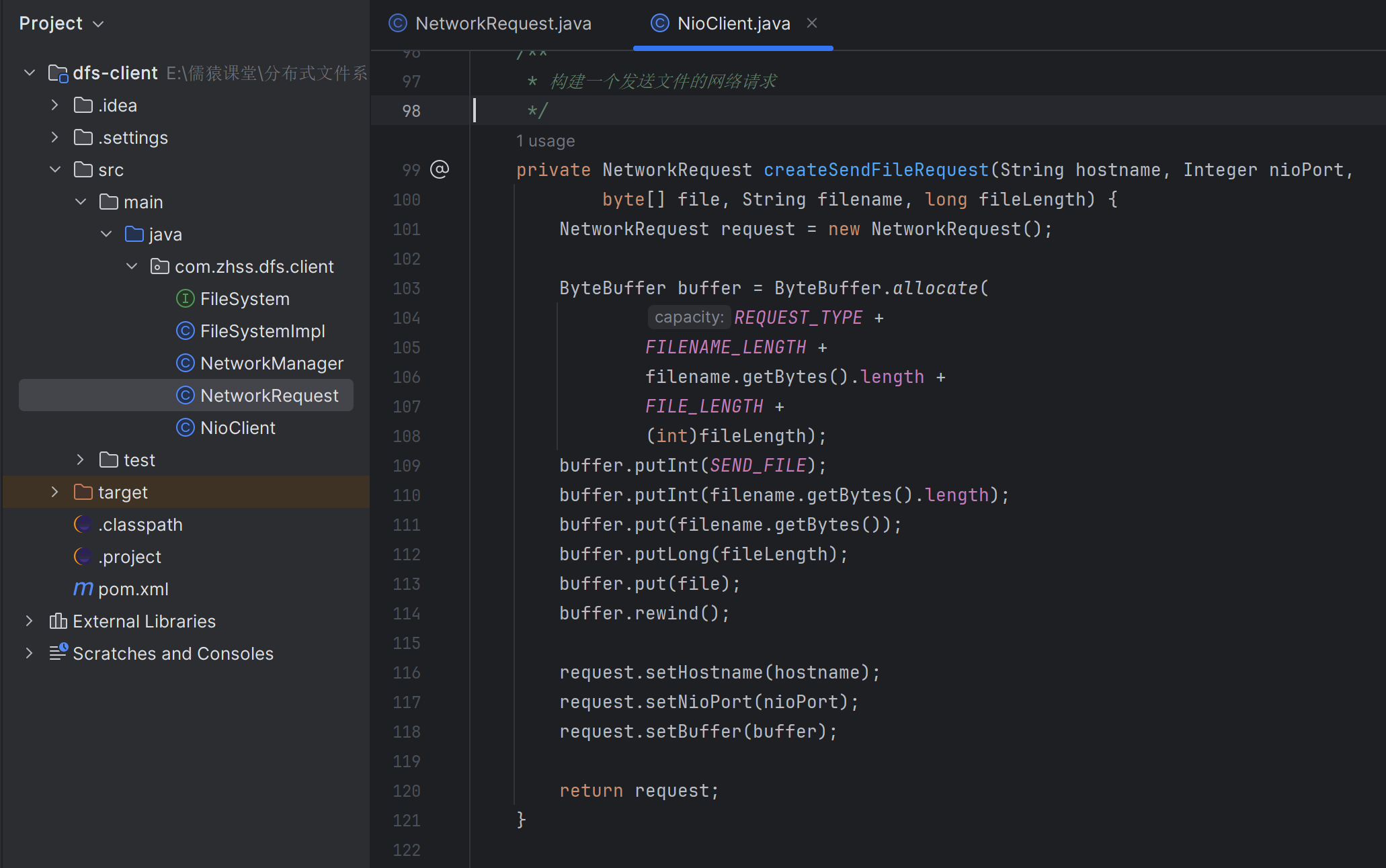小文件系统的请求异步化高并发性能优化
222_分布式图片存储系统中的高性能指的到底是什么?
重构系统架构,来实现一个高性能。然后就要做非常完善的一个测试,最后对这个系统做一个总结,说说后续我们还要做一些什么东西。另外,我还要给大家留一些作业,相当于是让大家课后自己去做的,就不是完全拷贝我的代码
高并发
前面已经通过Reactor模式实现了
高性能主要是两块
第一块:客户端现在是短连接,每次发送请求,都需要建立连接,然后断开连接。站在客户端的角度而言,发现每执行一次文件上传和下载的操作,速度都很慢
第二块:文件上传,需要多副本上传。一般来说,针对kafka,多副本的时候默认情况下只要写成功一个副本,就返回了。另外其他的副本的写都是异步慢慢来执行的,kafka采取的是副本pull数据的机制,只要在一个数据节点上写成功数据,别的数据节点会主从从这个写成功的数据节点上pull数据
Kafka,强调高性能,生产消息的行为都是尽快的可以完成
HDFS,不强调高性能,它主要针对的是几个GB的大文件上传到服务器上去,只要慢慢上传就可以了,速度慢点无所谓,只要能上传成功。所以,HDFS采用的是多个副本一定要依次上传成功,才可以说是本次文件上传成功了。所以,HDFS的上传速度肯定是很慢的,因为它们根本不强调文件上传过程的高性能。所以Kafka和HDFS的应用场景本身就不相同
高性能架构的重构
- 短连接 -> 长连接;
- 同步上传多副本 -> 写一个副本,其他副本在后台慢慢的异步复制和拉取
这样,文件上传和文件下载,性能至少会提升好几倍
223_回头审视一下客户端的短连接模式有哪些问题?
除了客户端有NioClient以外,数据节点也有NioClient,因为他在进行数据节点扩缩容时,需要从其他的数据节点拷贝副本过来写入本地,这个过程使用短连接也无所谓,因为这个过程都是后台慢慢执行的,但是当然最好也是重构成长连接模式
224_初步实现用于进行网络管理的NetworkManager组件
225_在NetworkManager中实现核心线程无限循环进行poll操作
NetworkManager
java
/**
* 网络连接管理器
*/
public class NetworkManager {
// 正在连接中
public static final Integer CONNECTING = 1;
// 已经建立连接
public static final Integer CONNECTED = 2;
// 多路复用Selector
private Selector selector;
// 所有的连接
private Map<String, SocketChannel> connections;
// 每个数据节点的连接状态
private Map<String, Integer> connectState;
// 等待建立连接的机器
private ConcurrentLinkedQueue<Host> waitingConnectHosts;
public NetworkManager() {
try {
this.selector = Selector.open();
} catch (IOException e) {
e.printStackTrace();
}
this.connections = new ConcurrentHashMap<String, SocketChannel>();
this.connectState = new ConcurrentHashMap<String, Integer>();
this.waitingConnectHosts = new ConcurrentLinkedQueue<Host>();
new NetworkPollThread().start();
}
/**
* 尝试连接到数据节点的端口上去
*/
public void maybeConnect(String hostname, Integer nioPort) throws Exception {
synchronized(this) {
if(!connectState.containsKey(hostname)) {
connectState.put(hostname, CONNECTING);
waitingConnectHosts.offer(new Host(hostname, nioPort));
}
while(connectState.get(hostname).equals(CONNECTING)) {
wait(100);
}
}
}
/**
* 尝试把排队中的机器发起连接的请求
*/
private void tryConnect() {
try {
Host host = null;
SocketChannel channel = null;
while((host = waitingConnectHosts.poll()) != null) {
channel = SocketChannel.open();
channel.configureBlocking(false);
channel.connect(new InetSocketAddress(host.hostname, host.nioPort));
channel.register(selector, SelectionKey.OP_CONNECT);
}
} catch (Exception e) {
e.printStackTrace();
}
}
// 网络连接的核心线程
class NetworkPollThread extends Thread {
@Override
public void run() {
while(true) {
tryConnect();
}
}
}
// 代表了一台机器
class Host {
String hostname;
Integer nioPort;
public Host(String hostname, Integer nioPort) {
this.hostname = hostname;
this.nioPort = nioPort;
}
}
}226_在无限循环的poll方法中完成网络连接的建立
java
public class NetworkManager {
// 正在连接中
public static final Integer CONNECTING = 1;
// 已经建立连接
public static final Integer CONNECTED = 2;
// 网络poll操作的超时时间
public static final Long POLL_TIMEOUT = 500L;
// 多路复用Selector
private Selector selector;
// 所有的连接
private Map<String, SocketChannel> connections;
// 每个数据节点的连接状态
private Map<String, Integer> connectState;
// 等待建立连接的机器
private ConcurrentLinkedQueue<Host> waitingConnectHosts;
public NetworkManager() {
try {
this.selector = Selector.open();
} catch (IOException e) {
e.printStackTrace();
}
this.connections = new ConcurrentHashMap<String, SocketChannel>();
this.connectState = new ConcurrentHashMap<String, Integer>();
this.waitingConnectHosts = new ConcurrentLinkedQueue<Host>();
new NetworkPollThread().start();
}
/**
* 尝试连接到数据节点的端口上去
*/
public void maybeConnect(String hostname, Integer nioPort) throws Exception {
synchronized(this) {
if(!connectState.containsKey(hostname)) {
connectState.put(hostname, CONNECTING);
waitingConnectHosts.offer(new Host(hostname, nioPort));
}
while(connectState.get(hostname).equals(CONNECTING)) {
wait(100);
}
}
}
// 网络连接的核心线程
class NetworkPollThread extends Thread {
@Override
public void run() {
while(true) {
tryConnect();
poll();
}
}
/**
* 尝试把排队中的机器发起连接的请求
*/
private void tryConnect() {
try {
Host host = null;
SocketChannel channel = null;
while((host = waitingConnectHosts.poll()) != null) {
channel = SocketChannel.open();
channel.configureBlocking(false);
channel.connect(new InetSocketAddress(host.hostname, host.nioPort));
channel.register(selector, SelectionKey.OP_CONNECT);
}
} catch (Exception e) {
e.printStackTrace();
}
}
/**
* 尝试完成网络连接、请求发送、响应读取
*/
private void poll() {
SocketChannel channel = null;
try {
int selectedKeys = selector.select(500);
if(selectedKeys <= 0) {
return;
}
Iterator<SelectionKey> keysIterator = selector.selectedKeys().iterator();
while(keysIterator.hasNext()){
SelectionKey key = (SelectionKey) keysIterator.next();
keysIterator.remove();
// 如果是网络连接操作
if(key.isConnectable()){
channel = (SocketChannel) key.channel();
if(channel.isConnectionPending()){
while(!channel.finishConnect()) {
Thread.sleep(100);
}
}
System.out.println("完成与服务端的连接的建立......");
InetSocketAddress remoteAddress = (InetSocketAddress)channel.getRemoteAddress();
connectState.put(remoteAddress.getHostName(), CONNECTED);
connections.put(remoteAddress.getHostName(), channel);
}
}
} catch (Exception e) {
e.printStackTrace();
if(channel != null) {
try {
channel.close();
} catch (IOException e1) {
e1.printStackTrace();
}
}
}
}
}
// 代表了一台机器
class Host {
String hostname;
Integer nioPort;
public Host(String hostname, Integer nioPort) {
this.hostname = hostname;
this.nioPort = nioPort;
}
}
}227_客户端的核心业务方法对要发送的请求进行封装
